Trauma Associated with Female Imprisonment
Within the United States more than 200,00 women are imprisoned, most of which are for non-violent crimes. As opposed to their male counterparts, female incarceration generally exists due to illegal actions associated with petty crime either stemming from drug use, or a need to provide for their children. The United States has the highest number of incarcerated women worldwide and much of this is a result of trauma related experiences within their lives prior to incarceration.

Unfortunately our prison system is based on a male model and doesn’t take into consideration the sensitive nature of women who have been traumatized. Many women have experienced long term physical or sexual abuse and therefore are further subjected within the prison system. “Imprisonment itself can have serious mental health effects, particularly for women with children and a history of victimization. The prison experience is not an isolated encounter. Rather, it may serve to exacerbate women’s trauma while, equally, the trauma may exacerbate the prison experience for women.” (Moloney, Bergh, Moller) Trauma and prison are many times intertwined as women enter incarceration with a multitude of past trauma and do not receive trauma related care within the system, which not only exacerbates their difficulties but leads to repeat offenses. Oftentimes women are held for longer periods of time within their local jails as female offenders generally have less income than males and are unable to post bail or seek the legal representation they may need. The notable income disparity between men and women within the criminal justice system further exemplifies the need for gender specific approaches.
Youth offenders also make up a large population of those within the prison system, if these young women are not assisted with their healing they are likely to reoffend and spend many years of their lives within the criminal justice system. “A gender-responsive approach comprehensively addresses the unique and specific needs of girls, creates an environment that reflects the realities of girls’ lives, and acknowledges their unique developmental experiences and pathways to problem behaviors. “ (Harris, Fitton) Programs that help promote healing, self esteem, financial independence, and control over ones own body can help women both young and old develop tools to heal and move forward with better coping mechanisms.

We as a society need to take into consideration the role that trauma plays in incarceration rates. If we hope to make the public safer, we must implement ways to help the incarcerated process and attempt to recover from their trauma. Simply locking a woman up for prostitution or drug use, doesn’t confront the underlying issues as to why they are involved in illegal activity. We need a more comprehensive analysis of the data associated with women who are incarcerated, the way in which they are held Prison vs. Local Jail, the reasons for their crimes, and how they are being treated within the system. Women inmates have different needs than their male counterparts and our criminal justice system needs to implement more gender responsive approaches to help women combat their trauma while incarcerated.
Sources:
R. Walmsley, (2006) World female imprisonment list. International Centre for Prison Studies, London. Sourced From: http://fileserver.idpc.net/library/world_female_prison_4th_edn_v4_web.pdf
K.P. Moloney,B.J. van den Bergh,L.F. Moller (2009) Women in prison: The central issues of gender characteristics and trauma history. Published by Elsevier.
Danielle Arlanda Harris, PhD 1, (2010) Yoga Therapy in Practice The Art of Yoga Project: A Gender-Responsive Yoga and Creative Arts Curriculum for Girls in the California Juvenile Justice System Published in: INTERNATIONAL JOURNAL OF YOGA THERAPY
3 comments
Hello,
Great post! Often enough we tend to forget that there are females prisons too! Usually those prisons house the worst females society has to offer. Sometimes there are those that made a horrible mistake and regret it very dearly. They’re surrounded by those that can bully them and traumatize them to an extent of no return. Great blog!
Hillary,
Great post! You are 100% correct on that the United States prison system is based on a male model. With everything that is going on in the world but more specifically the United States it is time to have a conversation on how women are treated in the prison system and also how women of color are treated differently than white women and how trauma plays a huge role in them being able to recover from the experiences while incarcerated.
Hillary – I loved your post! The graphics really added to your message and I think this topic is so crucial to bettering our criminal justice system. I really appreciated that you pointed out just how intertwined trauma and incarcerated females are – both the trauma that leads an incarcerate female to prison AND the trauma they go through in prison.
I work with a woman who was formerly incarcerated – she has completely turned her life around thanks to a gender-responsive post-prison system and furthering her education. She said that this program was the first time she EVER remembers feeling safe; it taught her that there was so much more out there for her. It shocks me to think of all the women that are engaging in criminal behavior simply because they have had a traumatic, unstable life. I think that gender-responsive prisons and programs are key to rehabilitation.
Without ensuring stability and an overall feeling of safety, the criminal justice system will simply continue to traumatize the incarcerated.
Comments are closed.